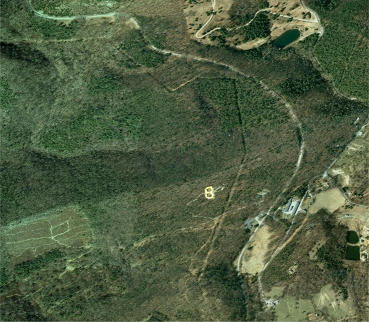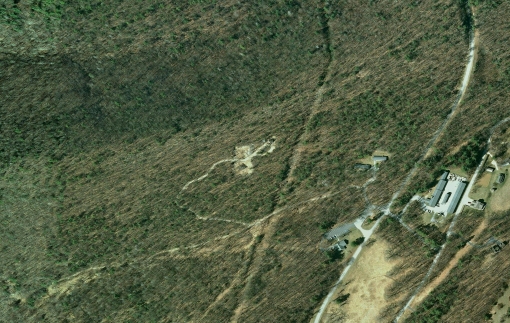The north loop, looking East. The small burn pile has been taken over by exotic plants: black raspberries, alanthes, and others, creating a small amount of shade in the dry limbs, long grass and ferns. The north loop is in direct sunlight the entire day. The surrounding woods has a dense canopy with very little direct sunlight reaching the rocky forest floor. Wildlife, including Box turtles, likely see the "bright sky" of the openings, from a long distance in the woods.
Cabin Meeting Area: The Creation of a New Man-made Meeting Area and an Adaptive Use by the Local Box Turtle Population
In 2006-2007, a small area of woods was cleared and leveled to serve as a lumber and supplies storage area for the construction of a log cabin nearby. After the storage was no longer needed, the area was used as a burn and stump pile and mostly left alone except for the collection of downed limbs and wood scrap.
Occassionally, since 2011, a few Box turtles have been tracked to this cleared area, but until 2018, these turtles were mostly turtles who's primary activity area is Edsel Hollow; where they were found, meet, mate, and hibernate. These resident turtles were M15(m), M4(f) and M19(m), in 2011 and M38(f) in 2015.
In 2018, a total of 10 residents were tracked to or found within this new meeting area. Many of these visitors traveled long distances from their previous locations or activity areas, and a number were found mating or meeting with other study area residents.
This photo shows the new meeting area. This view is looking south from the forest edge. In the immediate foreground is the northern or "upper" loop with it's small burn pile and recently mowed grass. The clearing in the background, on the other side of the dirt road, is the southern or "lower" loop, with it's ferns, grass and decaying stumps. Each loop measures approximately 100 feet in diameter, or 0.2 acres.
Clearings appear naturally in the woods, usually as a result of "blowdown", especially the snapping of large, overmature pines in heavy winds. These small natural clearings, like forest "edge" are short-lived, as seedlings quickly close in the bare forest floor. In the meantime they are valuable to Box turtles as places to meet, mate, and bask. Once visited, Box turtles seem able to remember these locations and even dates of previous meetings, etc. and make visits in future seasons.
.
Together, on an aerial photo, the two loops appear as a 'figure 8", or "bowtie", and is an easy landmark to find visually. On the ground, the meeting area and cabin site are mostly hidden from view through the woods. There's a steep rocky slope and ridge immediately to the north, with a large, rugged drainage on the other side of the ridge.
Near the center of this photo is the Cabin Meeting Area, located by the figure-8. The colored lines are the routes of 10 Box turtles that traveled to the meeting area during the 2018 season. Most turtles returned to their primary activity areas, a couple moved on, and one, M43(F), stayed and hibernated in the woods near the meeting area.
The study turtles that used this meeting area in the 2018 season are; M15(m), Yellow, M19(m), Purple, M38(f), Orange, M4(f), Green, M40(f), Blue, M41(f), Pink, M43(f), Aqua, M49(f), Red, M50(m), Light Blue, and M51(m), Gray.
The meeting area was used from about May 11th to October 6th, but the vast majority of use occurred from about June 1st until about July 31st. with the Edsel Hollow resident turtles (including especially M51) being the most frequent users.
This hollow is well know to have had a number of transient turtles found here, and others pass through, and to have a number of study turtles establish primary activity areas here. But this area is little different from most other parts of the study area, so why did so many turtles travel long distances this season to visit this area before returning.?
This close up of the meeting area shows the use by the Box turtles who visited during 2018, as well as turtles who were located very close by, and were supected to have used the meeting area. It also shows that not only were a number of study turtles able to navigate to this area, often traveling over several ridges, they were able to travel directly into the small clearing of the meeting area, likely traveling toward the bright sky.
The colored lines are tracked travel routes. Tracking turtles at this site only took place every 4 or 5 days during the 2018 season, so visits and activities that took place the other 3 or 4 days per week are not known.
If these turtles traveled here as a result of remembering past visits, they certainly would have been found here over the past 8 or 9 tracking seasons.
This page is under construction
Eastern Box Turtle
Terrapene carolina carolina
A Relict Population Doomed To Extinction?
Cabin meetig site turtle visitation for the 2023 season.
Yellow - M73(male)
Blue - M38 (female)
Orange - M49 (femae)
Green - M40 (female)
Pink - M1 (female)
M1 last visited in 2017, M43 was expected, but did not visit this season, M73 was newly found in 2022 at this site mating with M38, traveled widely, and returned at least twice during the summer. Turtle M38 is a resident female who stays close within the cabin site, including hibernation, every season.
The cabin site is visited by turtles traveling long distances from several adjacent drainages every season. Some like M40 visit every season, and some visit only in occassional seasons.




